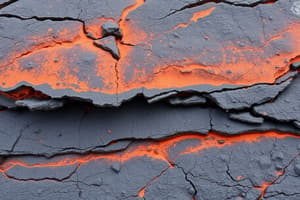Podcast
Questions and Answers
What is petrology?
What is petrology?
The scientific study of rocks and the conditions under which they form.
Which of the following are types of magma?
Which of the following are types of magma?
- Felsic (correct)
- Ultramafic (correct)
- Intermediate (correct)
- Mafic (correct)
Decompression melting occurs when magma is heated to a higher temperature.
Decompression melting occurs when magma is heated to a higher temperature.
False (B)
The process of adding _____ to magma can lower its melting point.
The process of adding _____ to magma can lower its melting point.
What is Bowen's Reaction Series?
What is Bowen's Reaction Series?
Which of the following are intrusive igneous structures?
Which of the following are intrusive igneous structures?
Flashcards are hidden until you start studying
Study Notes
Petrology Overview
- Petrology is the study of rocks, their composition, formation, and classification.
- It includes three main rock types: igneous, sedimentary, and metamorphic.
Rock Cycle
- The rock cycle describes the continuous transformation of rocks between igneous, sedimentary, and metamorphic forms.
- Processes involved in the rock cycle include weathering, sedimentation, heat and pressure, and melting.
Igneous Petrology
- Igneous rocks form from the solidification of magma or lava.
- Magma is molten rock located beneath the Earth's surface, while lava is magma that reaches the surface.
Types of Magma
- Magma types are differentiated based on composition and temperature:
- Ultramafic: very high in magnesium and iron, low in silica.
- Mafic: rich in iron and magnesium, moderate silica content.
- Intermediate: balanced silica content, between mafic and felsic.
- Felsic: high in silica, low in iron and magnesium.
Magmatic Processes
- Key magmatic processes include:
- Temperature increase: raising the temperature causes rock to melt.
- Decompression melting: occurs when pressure decreases, allowing magma to form.
- Addition of volatiles: introducing gases lowers melting points, facilitating magma formation.
Magma Series
- Bowen’s Reaction Series illustrates the crystallization sequence of minerals from cooling magma.
- It explains how different mineral compositions crystallize at varying temperatures.
Intrusive Igneous Structures
- Intrusive igneous rocks form when magma cools and solidifies within the Earth's crust.
- Common structures include:
- Plutons: large, solidified bodies of magma.
- Sills: horizontal layers of igneous rock between existing strata.
- Dikes: vertical or steeply inclined igneous intrusions.
Igneous Rocks
- Characteristics of igneous rocks are determined by their origin and cooling history.
- Examples include basalt (mafic) and granite (felsic).
- Textures range from coarse-grained (intrusive) to fine-grained (extrusive).
Studying That Suits You
Use AI to generate personalized quizzes and flashcards to suit your learning preferences.




